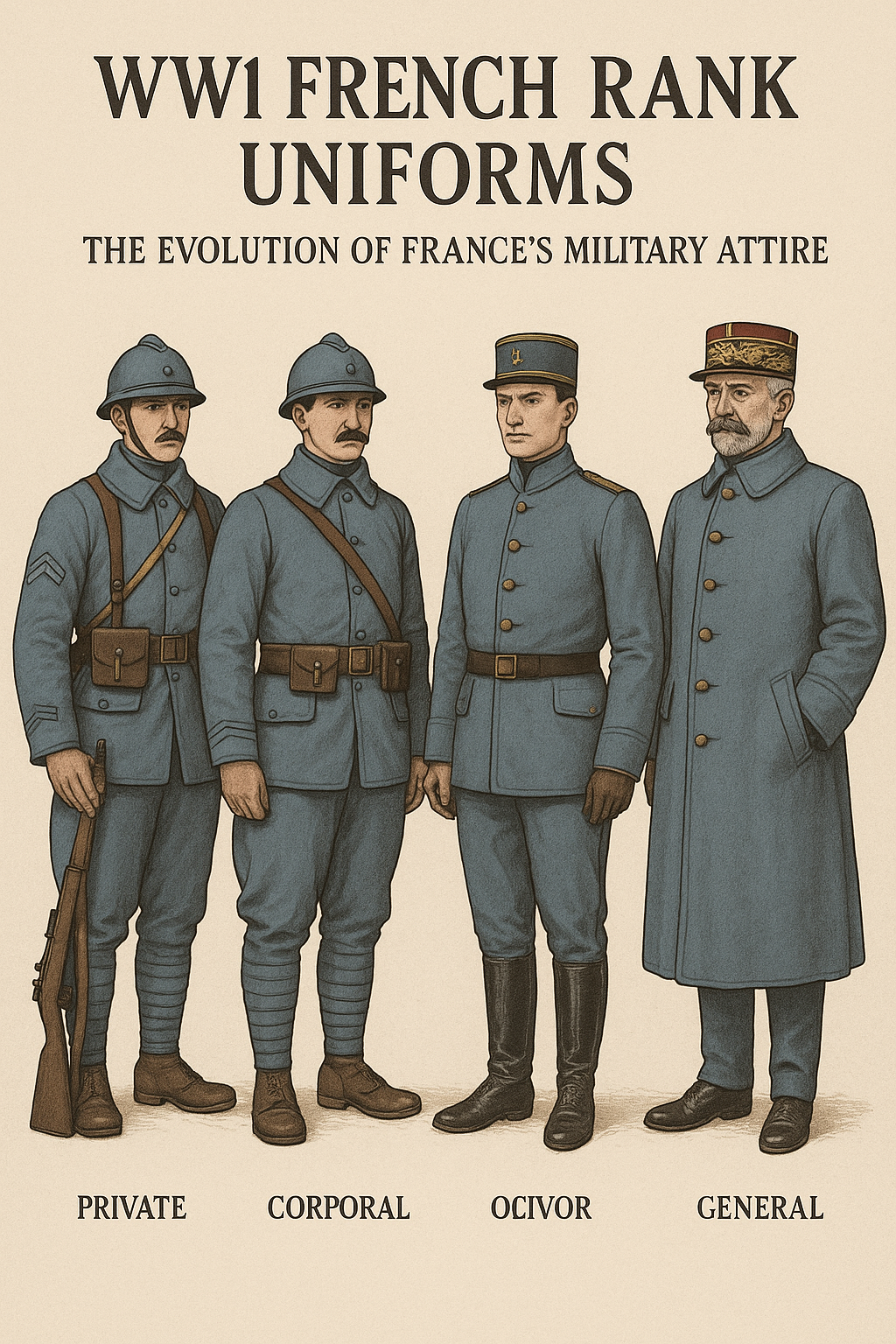
WW1 French Rank Uniforms: The Evolution of France's Military Attire
Published on May 09, 2025
WW1 French Rank Uniforms: A Historical Overview
French military uniforms during World War I are among the most iconic in modern history. More than just clothing, they were visual representations of a soldier’s rank, regiment, and national pride. Throughout the war, French WW1 uniforms underwent significant changes to adapt to new combat realities, and their design continued to influence modern military gear.
The Traditional Uniform at the Start of the War
In 1914, at the outbreak of World War I, the French Army entered the conflict wearing a uniform that many considered outdated. Infantry soldiers wore dark blue wool tunics paired with striking red trousers—a nod to military pride and Napoleonic tradition. While visually impressive, these uniforms made soldiers easy targets on the battlefield.
Officers and enlisted men were distinguished through subtle differences in materials, insignia, and headgear. Higher-ranking officers typically wore better-quality fabrics and carried symbolic accessories such as sashes or decorative swords.
However, as the war dragged into trench-based warfare, the French realized that their ornate uniforms were impractical for modern combat.
The Shift to Horizon Blue
By 1915, the French Army began outfitting troops in what became known as the horizon blue uniform. This soft blue-grey colour was chosen for its ability to blend into the landscape of the Western Front. The shift marked one of the most dramatic uniform changes in French military history. It was symbolic of a broader modernization effort.
Key Features of the Horizon Blue Uniform:
- Wool Tunic and Trousers: Standard issue, thick wool provided warmth and durability.
- Adrian Helmet: Introduced to protect soldiers from shrapnel and debris, painted in matching horizon blue.
- Puttees: Long cloth strips wrapped around the lower leg to provide ankle support and protection.
- French Greatcoat: A staple piece that combined style with function, especially crucial in trench warfare conditions.
Understanding French Military Ranks Through Uniforms
Rank distinctions in WW1 French uniforms were not just for formal show—they played a crucial role in maintaining order in the chaos of war.
Rank Indicators:
- Chevrons on Sleeves: Indicated years of service or wounds received in combat.
- Epaulettes and Braiding: Denoted officer status; the more elaborate, the higher the rank.
- Colour of Insignia: Gold for infantry and administrative services, silver or white for cavalry and mounted troops.
- Uniform Cut and Detail: Higher ranks typically had more tailored and ornate versions of standard uniforms.
These identifiers were vital for command and communication during battle, especially when verbal communication was nearly impossible amidst artillery fire and smoke.
The Iconic French Greatcoat
Among the most recognizable pieces of the WW1 French uniform is the French greatcoat, or capote. This heavy wool overcoat was essential for trench life, offering protection from the cold, rain, and snow.
Design Highlights:
- Colour Transition: Originally navy blue, it eventually changed to horizon blue in line with other uniform updates.
- Construction: Double-breasted front with large lapels and a high collar for protection.
- Utility: Deep pockets and a generous cut allowed for easy movement and storage of essential items.
- Durability: Built to last in the harshest battlefield conditions.
Even today, reproductions of the French greatcoat are popular among reenactors and collectors due to their historical accuracy and timeless design.
French Foreign Legion Mountain Commando Group
The French Foreign Legion Mountain Commando Group (Groupement de Commandos de Montagne) is one of the most elite units in the French military, with a reputation for endurance and adaptability in extreme conditions. While their current uniforms differ from those of WW1, their origins can be traced to early commando-style training and specialized gear during the war.
Uniform Features of the Commando Group:
- Camouflaged Attire: Designed for high altitude and rugged terrain, their modern gear still reflects the spirit of adaptability first developed in WW1.
- High-Performance Footwear: Suited for climbing and rough terrain, a stark contrast from the leather-soled boots of earlier years.
- Layered Clothing System: Allows commandos to remain agile in both arctic cold and rocky terrain.
- Tactical Equipment: Vests, harnesses, and specialized backpacks enable better gear management during operations.
Though not wearing traditional WW1 attire, the Mountain Commando Group is the evolution of specialized forces first seen in France during the Great War.
Why WW1 French Uniforms Still Matter
Military enthusiasts and historians continue to study WWI French uniforms not just for their aesthetics but for what they represent. Each uniform element—colour, cut, fabric, and insignia—tells a story of transition from a romantic view of warfare to the harsh realities of industrial-scale conflict.
Collectors value the craftsmanship and variations of these garments. Museums proudly display original and reproduction uniforms to educate future generations. And designers sometimes even draw inspiration from these classic looks for modern fashion and media.
Conclusion
The story of WW1 French rank uniforms is one of tradition giving way to practicality, of national pride adapting to the brutal demands of a new kind of warfare. From the bright red trousers of 1914 to the shadowy horizon blues of 1918, each uniform captures a unique moment in history. Add to that the elite gear of the French Foreign Legion’s Mountain Commandos, and you have a complete picture of how military uniforms France has produced reflect both heritage and innovation.
